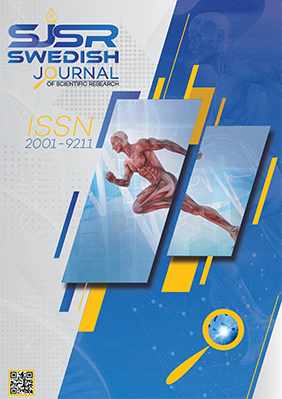SWEDISH JOURNAL OF SCIENTIFIC RESEARCH
SJSR March issue2018 | Issue 1 / MARCH |
|---|---|
|
P. 1 - 6
SJSR-000292
|
Background: Adolescence begins with the onset of physiologically normal puberty and this period of development corresponds to the adolescents nutritional status. As stated by the World health Organization, anthropometric assessment represents a crucial indicator of a population health. Objective: This study aimed to assess the obesity prevalence and habitual dietary habits of school aged adolescents in different governorates of Oman. Subjects & Methods: This cross-sectional survey consisted of a convenient sample of 4252 subjects recruited from the eleventh governorates in Oman, their age ranged between 15-17 years. Written informed consent was obtained, and a diet, anthropometric, and a medical history questionnaire was administered to all enrolled study subjects. Results: The study showed that almost half of the population had a normal body mass index (BMI). Obesity, overweight and underweight represented (15%,11%, 23% respectively). Female had higher percentage of overweight and obesity, while male had higher percentage of underweight. Only 50% of the population had breakfast more than three times a week. Fifty and forty percent of adolescents were having fruits and vegetables servings less than 4 times a week, respectively. Surprisingly, 20% reported junk food consumption 4-7 times a week. There was a significant correlation between BMI and the geographic distribution of the population; Al Dakhilia governorate showed the highest percent for underweight (27.9%), overweight and obesity was highly noticed in Dofar governorate (25.6%, 20.6% respectively). Conclusion: Adolescence is a second sensitive developmental period in which puberty and brain maturation lead to a new set of behaviors and capacities. Early intervention program has an important role in changing nutritional behavior of adolescents to assure raising healthier generation.
Majid S. AL Busafi1, et al, 2018. Anthropometric Attributes and Dietary Practices of School aged Adolescents in Different Governorates of Oman . Swedish Journal of Scientific Research.; 5(1):1-6.
|
|
P. 7 - 11
SJSR-000293
|
Objective: This study aims to investigate the common injuries in team and individual sports, and the common related training mistakes that lead to the injuries. Method: This is a cross sectional study, covering 262 athletes through an online survey. The survey aims to investigate the main injury factors, injury first aiders, and injured athletes’ satisfaction with the support provided by the first aiders. Result: Fifty-nine percent of the participants classified their injury as moderate. Thirty-four of the participants noted that failure to warm-up before performing is one of the main injury factors. Almost half of the participant did not receive rehabilitation after an injury that needed surgical intervention. Dr. Majid AL Busafi, et al, 2018. The most Common Injuries in Team and Individual Sports, and Related Training Mistakes Case Study: Sultanate of Oman. Swedish Journal of Scientific Research.; 5(1):7-11.
|
|
P. 12 - 21
SJSR-000294
|
The aim of this study was to identify the contribution of some anthropometric, physical and physiological measurements in the level of numerical achievement in a running of 400- meter among students in the field of physical education. To achieve this, the study was conducted on a sample of (100) students from the Department of Physical Education at the Technical University of Palestine “Khadoori” (PTUK), between the ages of (18-23) years. The two researchers used the descriptive method of its relevance to the nature of the study. Besides, Anthropometric measurements were made in terms of stature length, body mass, arm length, leg length, length of the instep, circumference of the shoulders, circumference of the chest, circumference of the abdomen, circumference of the thigh, circumference of the leg), and physical measurements in terms of (10 seconds, divide 5 steps (right-and-left), 200-meter sprint, Gri Cooper (12) minutes. To be added, physiological measurements In terms of heart rate, resting time and postoperative stress, systolic and diastolic pressure at the time of rest and after exertion (Cooper), and maximum oxygen consumption (Vo2max). The two researches used the SPSS program in data analysis. The results of the study showed that the abdominal circumference and the instep length were the most anthropometric measurements contributing to the level of digital achievement of track event (400 m), which contributed to the interpretation of (13.8%) of running time. Based on these results, the researchers recommend that trainers should take appropriate anthropometric, physical and physiological measurements for each of the athletics activities.
Riad Khalifa, et al, 2018. Contribution of some anthropometric, physical and physiological measurements in the level of digital achievement in a running for 400 meters for students in the field of physical education. Swedish Journal of Scientific Research.; 5(1):12-21.
|


